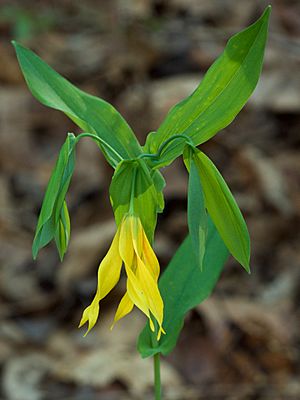Large-flowered bellwort facts for kids
Quick facts for kids Large-flowered bellwort |
|
|---|---|
 |
|
| Scientific classification | |
| Genus: |
Uvularia
|
| Species: |
grandiflora
|
Uvularia grandiflora, also known as the large-flowered bellwort or merrybells, is a beautiful flowering plant. It belongs to the plant family called Colchicaceae. This plant naturally grows in eastern and central North America.
Contents
What is the Large-Flowered Bellwort?
This plant can grow up to about 75 cm (30 in) tall and 30 cm (12 in) wide. It's a type of herbaceous perennial, which means it has soft stems (not woody like a tree) and comes back year after year. It grows from underground stems called rhizomes.
The leaves of the merrybells hang downwards and feel a bit fuzzy on their undersides. In the middle to late spring, you'll see large, yellow, bell-shaped flowers that also hang down. These flowers usually appear alone or in pairs. The top parts of the plant often bend over because the leaves and flowers are a bit heavy.
The stems are light green, smooth (which means glabrous), and have a slightly waxy, bluish-white coating (called glaucous). A cool thing about its leaves is that they are perfoliate. This means the stem looks like it's growing right through the middle of the leaf!
In late summer, the plant forms three small seed pods. When these pods open, they release seeds that have a special food body attached to them called an elaiosome. Ants love these food bodies, so they collect the seeds and help spread them around.
The scientific name grandiflora comes from Latin and means "large flowered," which perfectly describes its big, pretty blooms!
How is it Different from Other Bellworts?
The large-flowered bellwort is different from another plant called Uvularia sessilifolia. The sessile bellwort has smaller flowers, and its leaves attach directly to the stem without the stem appearing to pass through them.
It's also different from Uvularia perfoliata, which also grows in eastern North America and has similar large perfoliate leaves. However, U. perfoliata has flowers with little orange bumps on their petals, which U. grandiflora does not have.
Where Does the Large-Flowered Bellwort Grow?
The Uvularia grandiflora is found across a wide area in North America. Its natural home stretches from the Appalachian Mountains in the east, all the way west to the Dakotas, Kansas, and Oklahoma. In the south, it grows in Louisiana and Georgia, and in the north, you can find it in Manitoba, Ontario, and Quebec in Canada.
This means it's common in the eastern mountains, around the Great Lakes, and throughout the Mississippi Valley. You can also find some groups of these plants growing by Chesapeake Bay in Maryland.
What is the Habitat of the Large-Flowered Bellwort?
Uvularia grandiflora is a plant that loves to live in woodlands. You'll usually find it in places where there's open shade, like under tall trees. It prefers rich, moist soil that is either neutral or has a good amount of calcium (called calcareous soil).
Who Visits the Merrybells?
Many different kinds of bees love to visit the merrybells! Bumblebees, mason bees, halictid bees, and andrenid bees all come to feed on the sweet nectar and collect pollen from the flowers. However, it's not just insects that enjoy this plant; Deer also like to eat the leaves and stems of these plants.
Is the Large-Flowered Bellwort Protected?
In some parts of the United States, the Uvularia grandiflora needs special protection. It is listed as an endangered plant in both New Hampshire and Connecticut. This means there are very few of these plants left in those states, and efforts are being made to help them survive and grow.
How Did People Use This Plant in the Past?
Native American tribes have traditionally used this plant for different purposes. The Menominee people used Uvularia grandiflora to help with swellings. The Ojibwa people were known to use the root to help with pain in the stomach area, which might have been for a chest illness called pleurisy. The Potawatomi tribe would mix a special liquid made from the root with lard to create a salve. They would then massage this salve into sore muscles and tendons to help them feel better.
Can You Grow Merrybells in a Garden?
Yes, you can! In the United Kingdom, Uvularia grandiflora is a popular garden plant. It has even received the Royal Horticultural Society's Award of Garden Merit. This award means it's an excellent plant for gardeners to grow. There's even a special type of this plant called 'Pallida' that has flowers with a lighter color.


